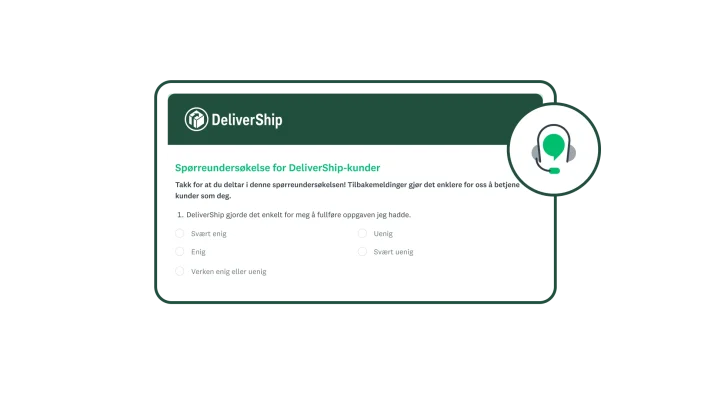Slik utvikler man et vellykket Kundens stemme-program

Når unngikk du en merkevare sist på grunn av noe du hadde hørt? Eller sluttet du å kjøpe fra et selskap som skuffet deg?
Hvor ofte henvendte du deg til disse bedriftene for å fortelle dem hvorfor du ikke kommer til å kjøpe mer fra dem?
Som den som har til oppgave å forbedre kundeopplevelsen, kan du ikke forvente at forbrukerne skal oppsøke deg. Det er i stedet du som må starte samtalen ved å fremme, implementere og opprettholde organisasjonens Kundens stemme-program.
Hva er et Kundens stemme-program?
Definisjon på kundens stemme: Kundens stemme er systematisk innsamling, analyse og overvåking av kundenes interaksjon med produktet, tjenesten eller merkevaren til bedriften.
Et Kundens stemme-program er viktig for den samlede kundeopplevelsen. Det er i bunn og grunn et løfte om å iverksette tiltak basert på tilbakemeldinger fra kunder. Ditt første mål er å tette hullene mellom kundenes forventninger og organisasjonens resultater. Når du opprettholder et effektivt Kundens stemme-program, gir du også de ansatte myndighet til å overgå kundens forventninger.
Skape et Kundens stemme-program kontra å samle inn tilbakemeldinger fra kunder
Mange organisasjoner ber kunder om tilbakemelding gjennom spørreundersøkelser, tilbakemeldingsskjemaer og fokusgrupper. Men et Kundens stemme-program er ikke bare innsamling av tilbakemelding. Når du lager et Kundens stemme-program for bedriften, gjør du kundeengasjement, -lojalitet og -tilfredshet til en viktig del av forretningsstrategien. Et godt Kundens stemme-program omfatter:
- konkrete forretningsmål
- støtte fra ledelsen
- medarbeiderdeltakelse og -samarbeid
- en omfattende forståelse av kundereisen
- proaktiv lytting til kunder på tvers av kanaler og kontaktpunkter
- jevnlige kunde- og markedsundersøkelser
- dataanalyse og -rapportering
- intern kommunikasjon
Det viktigste er at et godt Kundens stemme-program kan føre til handling. Bedrifter gjør det til en prioritet å følge opp tilbakemeldinger fra kunder ved å identifisere smertepunkter, fikse problemer og kommunisere disse endringene til både medarbeidere og kunder.
Les videre for å finne ut hvordan du bygger et eget Kundens stemme-program, fra planlegging til implementering og vedlikehold. Du får tips, viktige måledata og ressurser, som disse undersøkelsesmalene for Kundens stemme, for å hjelpe deg med å komme i gang.
Utvikling av Kundens stemme-programmet
1. Få oppslutning og støtte fra ledelsen
Å skape et Kundens stemme-program, eller å oppdatere et slikt program, krever tid og ressurser Før du setter i gang med en fullstendig plan, må du samle inn følgende informasjon og presentere den for ledelsen for å sørge for at alle er med på arbeidet:
- Viktige smertepunkter eller urovekkende måledata (som en økning på 5 % i kundefrafall fra år til år).
- Hva et Kundens stemme-program er – eller hvordan du mener det eksisterende Kundens stemme-programmet burde være.
- Noen få tilfellestudier fra andre selskaper viser hvor viktig det er å lytte til kundene og iverksette tiltak. Et eksempel er da busselskapet Greyhound økte et viktig kundelojalitetsmål med 15 poeng og gjorde viktige endringer i kundeopplevelsen, og dermed påvirket lønnsomheten sin.
2. Samarbeid med viktige interessenter for å sette mål
Når du har fått ledelsen med på laget, må du samarbeide med ulike team i hele bedriften. Alle interessenter har et unikt perspektiv på kundeopplevelsen. Og de har ulike måter å forbedre den på.
- Kundesuksess eller kundeservice jobber direkte med kundene, og de vet hva som er viktige smertepunkter og problemer med produktet eller tjenesten til bedriften.
- Markedsføring og kommunikasjon har konkurranse- og markedsinnsikt. De kommuniserer kanskje også direkte med forbrukerne over sosiale medier.
- Salgsavdelingen har god innsikt i prisfølsomhet, konkurrerende produkter og løsninger og hvilke budskap som fungerer (eller ikke fungerer) med potensielle kunder.
- Produktteamene kan opplyse om hvordan folk samhandler med produktet eller tjenesten til bedriften, inkludert data som frafall, feilmelding- og avbruddsfrekvens. De kan også gi deg en bedre forståelse av hvordan produktene fungerer og eventuelle problemer eller feil som kan påvirke kundetilfredsheten.
- Personalavdelingen kan fortelle om medarbeideropplevelsen. Er medarbeiderne engasjert? Føler de at de har mulighet til å påvirke kundeopplevelsen på en positiv måte?
Alle disse teamene kan ha forskjellige mål eller tanker om hva suksess betyr. Til å begynne med kan du velge ett mål for hele bedriften (f.eks. «forbedre kundetilfredsheten med 10 %») og oppmuntre hvert team til å sette sine egne mål.
Bare husk at dette er kundesentrert arbeid. Produktteamet ønsker kanskje å forbedre introduksjonsopplevelsen for å få flere registreringer. Men i forbindelse med et Kundens stemme-program ville det være bedre om produkt- og kundeserviceteamet samarbeider. Kundeservice kan påpeke viktige smertepunkter med introduksjonsopplevelsen, og produktteamet kan ta hånd om disse med mål om å redusere antall billetter til kundeservice.
3. Lage et kart for kundereisen
Sett deg ned med viktige interessenter for å tenke gjennom hvordan en kunde eller potensiell kunde samhandler med merkevaren før, under og etter at de kjøper noe fra dere. Dette kalles kartlegging av kundereisen, og kan fremheve muligheter til å samle inn tilbakemeldinger, lære mer om et bestemt kontaktpunkt eller fylle mangler i kundeopplevelsen. Vanlige kontaktpunkter for kunder finner sted før, under og etter et kjøp. Noen eksempler:
- Før kjøp: reklame, jungeltelegrafen og sosiale medier
- Under kjøp: nettsted, butikk og salgssted
- Etter kjøp: fakturering, transaksjons-e-poster og elektronisk hjelpesenter
Når du lager et kundereisekart, bør du også merke deg når, hvor og hvor ofte du ber om tilbakemelding fra kunder. Dette gjør det enklere å finjustere spørreundersøkelsene og planlegge og spore dem bedre.
Trenger du hjelp til å lage et kundereisekart?
Lær hvordan du lager et kundereisekart for å samordne interessenter og oppnå forretningsmålene.
4. Lytt til kundene
Når du lytter til kundene, samler du inn strukturerte og ustrukturerte (kvantitative og kvalitative) tilbakemeldinger i kundens stemme.
Strukturerte data er kvantifiserbare eller målbare. Du sender for eksempel ut en spørreundersøkelse som ber kundene om å rangere sannsynligheten for at de vil kjøpe fra deg på nytt. Fordi du ber dem om å velge mellom et sett med alternativer, har resultatene en numerisk verdi: 76 % av kundene sier de ville kjøpt produktet på nytt.
Ustrukturerte data er kvalifiserte eller ikke målbare. I undersøkelsen om kjøpsopplevelsen ber du for eksempel noen om å forklare hvorfor det er «svært sannsynlig» at de vil kjøpe fra deg på nytt. Du sørger for en tekstboks slik at de kan fortelle mer. Tekstsvarene du får, gir innsikt i «hvorfor» tallene er som de er.
For å få hele bildet av kundeopplevelsen er det en god idé å samle inn begge datatypene. Her er ulike måter du kan lytte til kunder regelmessig som en del av et effektivt Kundens stemme-program:
- Sørg for at du samler inn tilbakemeldinger med spørreundersøkelser om kundetilfredshet ved viktige kontaktpunkter for kunder, for eksempel etter et kjøp eller kontakt med kundeservice
- Oppmuntre teamene på tvers av bedriften til å jobbe med team som salg og kundeservice én gang i kvartalet
- Utfør jevnlige undersøkelser for kunder eller brukere for å få konkurransedyktig innsikt og se hvor du kan forbedre produktet eller tjenesten til bedriften
- Hold fokusgrupper og kundeintervjuer for å få grundig innsikt
- Øv på sosial lytting for å se hvordan folk oppfatter merkevaren
5. Innhent viktig Kundens stemme-statistikk
Det finnes noen måledata for Kundens stemme som bransjestandard, som bedrifter bruker for å få innsikt i kundeopplevelsen. Her tre av de mest populære måledataene for Kundens stemme.
Net Promoter Score (NPS)

Hvor sannsynlig er det at noen anbefaler bedriften din til en venn eller kollega? Spørreundersøkelsen Net Promoter Score® (NPS) gir et kvantifiserbart, lett sporbart svar på dette spørsmålet. Her er en oversikt over NPS-undersøkelsen.
- Enkel NPS-beregning: Respondentene gir en vurdering fra 0 til 10, og poengsummene er et tall fra -100 til +100.
- Sporbart og praktisk: Net Promoter Score-spørsmålet er enkelt og allsidig, uansett om du spør om noen vil anbefale merkevaren din eller appen eller programvaren din. NPS-spørsmålet er ikke knyttet til en bestemt hendelse, så det er en god indikator på hvordan organisasjonen til enhver tid presterer.
- Nyttige referansepunkter for bransjen: Fordi mange organisasjoner bruker NPS, kan du sammenligne handlinger med andre i samme bransje. For eksempel viser analysen vår av hundrevis av NPS-undersøkelser at 38 er gjennomsnittlig poengsum for helsetjenestebransjen.
Kundetilfredshetspoengsum

Selv om NPS viser kundelojalitet over tid, kan du bruke poengsummen for kundetilfredshet for å få innsikt i hva en kunde føler etter en bestemt interaksjon med merkevaren. Dette må du vite om en spørreundersøkelse om kundetilfredshet.
- Fungerer godt sammen med NPS: Både spørreundersøkelse om kundetilfredshet og NPS er viktige måledata for Kundens stemme og gir deg ulik, utfyllende innsikt i kundeopplevelsen.
- Spesifikt og gjennomførbart: Bruk spørreundersøkelse om kundetilfredshet for å foreta målrettede forbedringer i kundeopplevelsen. Du kan få tilbakemeldinger om kundeservice eller måle deltakernes tilfredshet ved å få tilbakemeldinger om arrangementer.
- Lett å beregne og analysere: Svaralternativene i en spørreundersøkelse om kundetilfredshet er basert på en numerisk skala, fra 1–5. Du kan se på rådataene, som at 478 kunder sa at de var «veldig fornøyde» med den nylige kontakten med kundeservice. Eller du kan se dataene som prosentandeler.
Poengsum for kundeinnsats

Hvor vanskelig eller enkelt er det for kunder å utføre visse oppgaver i samhandling med bedriften? Med poengsummen for kundeinnsats kan du finne viktige friksjonspunkter for kunden, for eksempel når de bruker programvaren til bedriften eller prøver å løse et spesifikt problem. Her er grunnen til at du bør bruke spørreundersøkelser for poengsum for kundeinnsats for å runde av Kundens stemme-programmet.
- Øk kundelojaliteten: Ifølge undersøkelsene våre er det sannsynlig at 91 % av forbrukerne anbefaler et selskap hvis innsatsen brukeren må legge inn i kontakt med bedriften er lav.
- Finn raske forbedringsmåter: Selv en uklar melding kan få kunder til å avbryte et kjøp. Hva hvis det å endre noen få ord i betalingsprosessen påvirker bunnlinjen?
- Lag bedre opplæringsprogrammer: Du kan bruke spørreundersøkelser om kundeinnsats til å forstå hvor kundeserviceteamet ikke er optimalt, for eksempel hvis representantene bruker for lang tid på å løse kundeproblemer. Når du vet hva som er vanskelig for kundene, kan du skreddersy kundeserviceopplæringen slik at vanlige problemer løses raskere.
6. Analyser resultatene
Når du begynner å samle inn tilbakemeldinger fra kunder ved alle kontaktpunktene, må du undersøke hvert datasett og sammenligne resultatene.
- Be partnerne dine som har andre funksjoner i bedriften, om å dele innsikten de har innhentet gjennom kunde- og markedsundersøkelser, sosiale medier og annet. All denne informasjonen bør være tilgjengelig på ett sted, som f.eks. en intern kunnskapsdatabase eller nettsted.
- Noen data, som Net Promoter Score, er lettforståelige. Men hvis du samler inn åpne tilbakemeldinger i spørreundersøkelser for kunder, kan du bruke et tekstanalyseverktøy til å avdekke skjulte trender.
- Du bør dele opp undersøkelsesdataene med avanserte analyseverktøy, som egendefinerte datafiltre, som kan berike undersøkelsesresultatene med dypere kundeinnsikt.
7. Iverksett tiltak, hold ved like og gjenta
Når du har utarbeidet strategien for å lytte til kundene, må du være oppmerksom på – og håndtere – alle umiddelbare problemer, som dalende NPS eller dårlig poengsum for kundetilfredshet.
På lang sikt må du skape et rammeverk for å opprettholde et solid Kundens stemme-program for organisasjonen. Her har du noen ideer.
- Påvirk produktveikartet: Produktteamene kan forplikte seg til å fikse ett eller to presserende kundeproblem én gang i kvartalet.
- Forbedre opplæringen og responsen til kundeservicen: Serviceteam kan prioritere bedre introduksjons- og empatiopplæring for medarbeiderne. Eller de kan lage maler med nyttige svar på de vanligste spørsmålene fra kundene, noe som reduserer responstiden.
- Engasjer hele bedriften: Bruk én eller to uker hvert halvår til å fokusere på å løse kundeproblemer eller svare på viktige tilbakemeldinger fra kunder.
- La kundene stå i sentrum: Inviter kundene til å fortelle om sine opplevelser til de ansatte på en regelmessig basis.
- Opplys om mangler og suksess: Vurder å sende månedlige rapporter til hele bedriften med viktige tilbakemeldinger, datatrender og kundehistorier som vil motivere de ansatte.
Fordeler med et Kundens stemme-program
Når kundene er fornøyde, er det mer sannsynlig at de forblir lojale mot merkevaren og anbefaler bedriften til andre. Men det er andre fordeler med Kundens stemme-programmet som kanskje ikke er like åpenbare.
Forbedre medarbeiderengasjementet
Når du utvikler et Kundens stemme-program, gjør du det mulig for medarbeiderne å påvirke kundeopplevelsen direkte. Du kan til og med oppmuntre teamene til å sette kundesentrerte mål og premiere dem for det de har oppnådd.
Få konkurransefortrinn
Mye av innsamlingen av tilbakemeldinger er reaktiv, noe som betyr at du bare forstår hva kundene føler etter at de har hatt kontakt med merkevaren til bedriften. Et Kundens stemme-program står også for proaktiv innsamling av tilbakemelding. Fokusgrupper, kundeintervjuer, lytting i sosiale medier, brukerundersøkelser – slik kan du finne muligheter til å utvikle nye produktideer, løse smertepunkter for forbrukere og annet.
Få enda flere anbefalinger fra kunder og sosiale bevis
Du kan bruke positive tilbakemeldinger fra, og samhandlinger med, kunder til å fortelle historier som gjør inntrykk om merkevaren til bedriften i alle kanaler, fra markedsføringsmateriell til nettstedet til bedriften og plattformer for sosiale medier.
Hvordan overvinne vanlige utfordringer ved Kundens stemme-programmer
Utfordring 1: Isolering av tilbakemeldinger og data fra kunder
Markedsundersøkelser, brukerinnsikt, tilbakemeldinger om kundeservice, interaksjoner i sosiale medier, resultater fra spørreundersøkelser: Dataene vil til sammen gi et fullstendig bilde av kundeopplevelsen. Men hvis dataene er isolert i separate systemer, er det vanskelig å fange opp trender og finne viktige muligheter for teamene i organisasjonen til å gjøre noe.
Gjør hver interessent eller team ansvarlig for å rapportere resultatene sine eller dele alt på ett sted. Du kan forenkle innhenting og administrasjon av tilbakemeldinger ved å integrere spørreundersøkelser med Salesforce, HubSpot, Mailchimp, Zendesk, Zoom og flere andre.
Utfordring 2: Kundene svarer ikke på spørreundersøkelser for tilbakemelding
Sender du ut spørreundersøkelser, men får ikke nok svar til å gi statistisk signifikante resultater? Vurder en kontroll av spørreundersøkelsene som en del av Kundens stemme-programmet, ved å gå gjennom en sjekkliste for beste praksis for spørreundersøkelser for hver undersøkelse.
Kunder kan ignorere spørreundersøkelsene dere sender ut hvis de er for lange eller forvirrende. Det er en god idé å bruke ekspertutviklede spørreundersøkelsesmaler og undersøkelsesspørsmål om kundetilfredshet for å få et pålitelig antall svar.
Er du fremdeles ikke sikker på hvorfor spørreundersøkelsene gir dårlige resultater? Sjekk disse tipsene for å øke svarfrekvensen for spørreundersøkelser om kundetilfredshet og anbefalte fremgangsmåter for spørreundersøkelser om kundetilfredshet.
Utfordring 3: Enkelte team er ikke interesserte i å være med
Hvis ideen om å gjøre kundene fornøyde ikke er nok til å få teamene til å prioritere å løse kundeproblemer, må du knytte kundetilfredshet til omsetning. Du kan for eksempel vise avkastningen ved å forbedre kundetilfredsheten ved at du knytter livstidsverdien for en kunde dere bevarer til antallet personer som sier de ville kjøpt fra dere igjen.
Støtt opp om argumentet ditt ved å dele overbevisende forskningsresultater med motvillige team. Våre undersøkelser viser blant annet at 75 % av kundene mister tilliten til en bedrift etter en dårlig produktopplevelse.
Fem beste fremgangsmåter for hvordan du lager Kundens stemme-programmet
Lag et Kundens stemme-program som fanger opp essensen i kundenes holdninger. Bruk følgende beste praksis for å engasjere kundene i en dialog, samordne bedriftens interessenter og skape slagkraftige endringer.
- Vær oppmerksom på implisitte data. Implisitte data, som appbruk eller frafallsfrekvens, er det motsatte av eksplisitte kundetilbakemeldinger. Kundene kan fortelle at de er fornøyde med appen, men hvis de ikke bruker den igjen, er det på tide å stille flere spørsmål.
- Før du starter dataanalysen, må du rydde opp i undersøkelsesdataene for å få de mest nøyaktige og gjennomførbare resultatene.
- Sjansen er stor for at jo mer fornøyd de ansatte er, jo bedre kundeopplevelse leverer bedriften. Samarbeid med personalavdelingen for å spore medarbeidernes engasjement og tilfredshet, for eksempel med en eNPS-undersøkelse. Dere kan til og med overvåke og spore viktige måledata for medarbeiderengasjement, som NPS for medarbeidere, opp mot kunde-NPS.
- Sett resultatene i sammenheng med noe. Dere overvåker selvfølgelig kundetilfredsheten over tid. Men dere bør også sammenligne resultatene med konkurrentene for å få en sant bilde av situasjonen.
- Sørg for at Kundens stemme-programmet er oppdatert. Hold deg oppdatert på hva de største kundeopplevelsestrendene er, inkludert hvordan kundeopplevelseseksperter navigerer KI og prøver å oppfylle forbrukernes forventninger som er i stadig endring.
Begynn å utvikle et Kundens stemme-program i dag
Send ut en spørreundersøkelse på noen få minutter med en av disse ekspertutviklede undersøkelsesmalene for Kundens stemme. Hvis du er på utkikk etter litt mer hjelp, kan du finne ut hvordan SurveyMonkey kan understøtte Kundens stemme-programmet for dere.
Net Promoter, Net Promoter Score og NPS er varemerker for Satmetrix Systems, Inc., Bain & Company, Inc. og Fred Reichheld.
Oppdag flere ressurser

Løsninger for nettopp din stilling
SurveyMonkey hjelper deg med å gjøre en bedre jobb. Oppdag hvordan du kan få større gjennomslag med vellykkede strategier, produkter, opplevelser og mer.

Hornblower forbedrer kundeopplevelsen verden rundt
Oppdag hvordan Hornblower bruker SurveyMonkey og kraftig KI til å få mest mulig ut av NPS-data, innhente kundeinnsikt og forbedre kundeopplevelsen.

Se hvordan Ryanair innhenter kundeinnsikt i stor skala
Oppdag hvordan Ryanair bruker SurveyMonkey og Microsoft Power BI-integreringen til å spore 500 000 CSAT-undersøkelser og forbedre kundeopplevelsen.

Se hvordan woom forbedrer medarbeider- og kundeopplevelsen
Se hvordan woom bruker SurveyMonkey til å lansere flerspråklige undersøkelser i stor skala, forbedre medarbeideropplevelsen og fange opp kundeinnsikt.